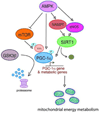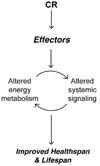Metabolic reprogramming, caloric restriction and aging
- PMID: 20004110
- PMCID: PMC2831168
- DOI: 10.1016/j.tem.2009.11.005
Metabolic reprogramming, caloric restriction and aging
Abstract
Caloric restriction (CR) without malnutrition slows the aging process and extends lifespan in diverse species by unknown mechanisms. The inverse linear relationship between calorie intake and lifespan suggests that regulators of energy metabolism are important in the actions of CR. Studies in several species reveal tissue-specific changes in energy metabolism with CR and suggest that metabolic reprogramming plays a critical role in its mechanism of aging retardation. We herein describe common signatures of CR and suggest how they can slow aging. We discuss recent advances in understanding the function of key metabolic regulators that probably coordinate the response to altered nutrient availability with CR and how the pathways they regulate can retard the aging process.
Copyright 2009 Elsevier Ltd. All rights reserved.
Figures



References
-
- Piper MD, Bartke A. Diet and aging. Cell Metab. 2008;8:99–104. - PubMed
Publication types
MeSH terms
Grants and funding
LinkOut - more resources
Full Text Sources
Other Literature Sources
Medical

